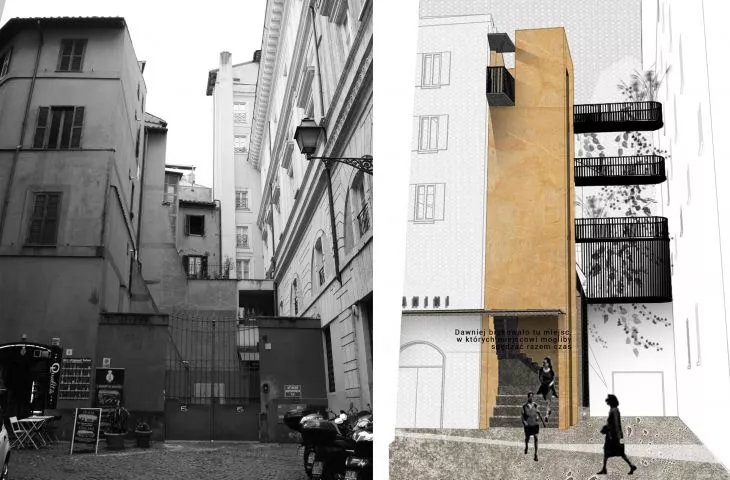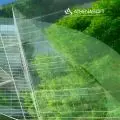Alicia Sienkiewicz, conducting observations of Roman neighborhoods, selected spaces where she proposed architectural interventions. In this way, objects were created to bind the urban fabric and introduce new social functions.
The aim of the project was to develop an architectural concept for a set of buildings that in their form and function would be a glue to Rome's existing buildings, and to draw attention to the potential of the smallest parts of the city. The project is a master's thesis carried out at the Wrocław University of Technology under the direction of Dr. Mark Lamber. The thesis was based on Alicja Sienkiewicz's research and analysis of Rome's urban and social structure, local inspections and interviews with residents.
An intervention in one of the selected spaces
© Alicja Sienkiewicz
As the author states:
"Binder Potential is a proposal for responding to the social and ecological problems of the modern world using Rome as an example. Loneliness, social confinement, lack of access to local food products, water management problems, droughts and heavy rainfall are examples of the problems many cities face. I believe that being guided by the idea of combating them in the first place is the direction in which contemporary design should go, and it is these priorities that I have tried to incorporate into the project.
Gaps in the urban fabric
Alicja Sienkiewicz divided her research into three stages, in which she chose neighborhoods, function and gaps in the urban fabric. These included 9 rioni (neighborhoods) of Rome: R.I Monti, R.II Trevi, R.III Colonna, R.IV Campo Marzio, R.V Ponte, R.VI Parione, R.VII Regola, R.VIII Sant'Eustachio, R.XIX Pigna. The analysis was aimed at learning about the urban, architectural and social situation of the neighborhoods and finding a suitable place for an architectural concept that meets the needs of the residents. The author evaluated, among other things, the height of buildings, access to public parks, the number and size of gaps, and the attractiveness of the neighborhood.
selected gaps and facility proposals
© Alicja Sienkiewicz
The next step was to identify the functions that the proposed intervention could serve. An important factor that the architect took into account in the design process was theopinion of residents, people who work or spend a significant part of the day in the neighborhood. To this end, she prepared a questionnaire to which locals responded.
The final stage concerned the selection of spaces for architectural intervention. For the project, Alicja considered Polish legal conditions, which she confronted with gaps in the development. The selection of sites was significantly influenced by a site visit conducted in April 2019, during which the author observed the lives of residents, analyzed the directions of people's movements, types of activities, and analyzed the aesthetic qualities of the sites. As a result, she selected three spaces most in need of intervention.
optical illusion vs. design
The author's idea of design is illustrated by the well-known optical illusion.
If we paint a black vase on top of a white one, we consider the black part as a figure , and the white part [...] as a background [...] However, if we consider the white as a figure and the black as a background [...] we will see something quite different. The vase disappears and its place is taken by two faces in profile.
Rasmusen, 2015
project idea, neighborhood projection
© Alicja Sienkiewicz
The author carried out a similar procedure on the projection of the 5th district of Rome, thus emerging a new city. It was this change of outlook that inspired the design concept. Another reference was also the idea of a communal Italian feast on the streets of the city. Alice remembered this sight from her childhood travels in Italy. The idea of living in community is making a contemporary comeback in the form of coliving and coworking, living and working together.
New objects in forgotten spaces
The designed buildings differ not only in form, but also in function, the choice of which was influenced by discussions with residents held earlier. Due to the small size of the plots of land, in each of the three cases thegap areas have been entirely allocated for development. All the buildings were created in a way that allows the first floors to be used for service or public utility functions.
The first selected gap is located in the central part of the Ponte district, and its space appears abandoned and neglected. Here the architect proposed a coliving building with a daycare center for children and a roof garden. The second selected space is adjacent to Palazzo Alberini, and a facility with a farm, garden and viewpoint would be built there. The last gap near Acciaioli Street consists of three parts. The author used the space above the first floor of the vacant building, the wall and the space behind it to create a facility with two-story apartments, coworking space and an urban farm.
The new facilities are proposals for urban gardens, coliving and coworking spaces
© Alicja Sienkiewicz
sustainable design
Thematerials used in the project were chosen with sustainable design principles in mind. The sandstone used on the facades is quarried in many places in Italy. The buildings' steel support structure allows to subtly combine elements of historical and contemporary architecture. Thanks to it, the structure of the existing buildings has been compromised to a minimum. The reinforced concrete elements that make up the foundations are easy to construct and do not require the use of heavy equipment, which is crucial in selected locations.
The author tried to show that even the smallest spaces have potential and importance in the structure of the city. In their form, they can complement the city, and in function, the social structure. There is potential in the gaps to realize the demands of residents and to mitigate the effects of global warming.
The project made it to the finals of this year's Zbyszek Zawistowski "Diploma of the Year" Award, the results of which will be announced in October. In addition to this work, the nominees for the award include: Anna Jaruga-Rozdolska with a project for a research center in Jordan, Iga Ostrowska with a project for a community development in Praga North, andTomasz Kruszyński author of the work entitled INVISIBLE SACRUM.
compiled by: Dobrawa Bies
illustrations courtesy of Alicja Sienkiewicz











































